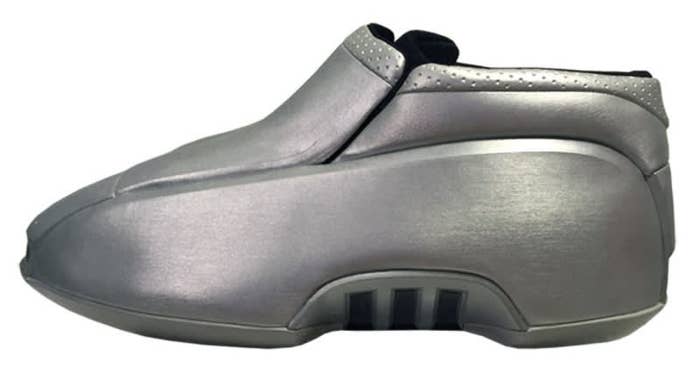
There are athletes with signature sneakers and then there’s Kobe Bryant.
While most of the general population will remember Kobe for the accolades he earned as a basketball player (and rightfully so), I’ll always remember him for changing the way I look at sneakers.
The first time I saw the Adidas KB8 (now the Crazy 8) was on my friend’s feet when I was in the seventh grade. I had to beg my mom to buy me a pair because Bryant was my favorite player. They were my first and only pair of “cool” sneakers at the time, and I wore them every day until the purple tread pattern on the outsole completely smoothed out as if they were buffed down with sandpaper.
Before even being drafted in the NBA in 1996, Bryant signed with Adidas to become the face of its Feet You Wear campaign, a line of sneakers that touted natural motion. He’s forever linked with some of the most memorable basketball sneakers in the company’s archive, for better or worse.

People still laugh at The Kobe One and Kobe Two, shoes that looked like something the Space Force would wear and had about the same flexibility as a brick. But never forget that Kobe won championships in those shoes and there was no basketball sneaker at the time created in partnership with an actual car company (Audi).
Eventually Kobe would shell out a reported $8 million to get out of his Adidas deal. As a footwear free agent during the 2003 NBA season, we really got to see Bryant’s love for sneakers show by what he was wearing from game to game—everything from Converse Weapons to Reebok Questions to Laker-themed retro Air Jordan PEs.
The Kobe brand found its footing when he signed with Nike and it was parallel to how his career was starting to get cemented. Someone once told me that when Nike reps came to meet with Bryant at his home, they found his closets filled with Nikes and Air Jordans, split open because he wanted to see the guts inside of them. If Bryant was never a pro basketball player, he would’ve been great working at the brand’s innovation kitchen.
“Right from the very first second, I was amazed at how intelligent, articulate, and creative he was,” Bryant’s sneaker designer and Nike creative director Eric Avar said. “He was absolutely dedicated to performance and wanted to understand all the functionality.”
I had the privilege of meeting and interviewing Bryant throughout my career. When it came to athletes talking about their shoes and actually believing what they were saying about them, there was no one like Kobe Bryant. As much of a psychopath he seemed to appear on the court, he was a giant nerd about making products that helped make himself and other basketball players play better.
“I don’t focus on how fashion changes. I only focus on creating innovative product,” Bryant told me in 2016 when I asked him how his sneaker line was going to continue after he retired. “Hopefully the consumer knows by now that if you’re buying a Kobe product, you’re buying something that’s been thought through. We pay attention to detail all the way through.”

The most radical sneaker in the Nike Kobe line was the Kobe 4. It came at a time when low-top basketball shoes hadn’t been common for two decades. It was also a sneaker that people inside the company were nervous to make if it wasn’t for Bryant pushing for it. Today, over 60 percent of NBA players wear low-top sneakers, and it was all driven from the curiosity, insight, and foresight of Bryant.
Even the way the Kobe 4 and other sneakers in the Kobe sneaker line came back were thought through meticulously. Protro was a concept Bryant created to have his old shoes still meet up to the standards of the current game. Who thinks like that?
“His shoes always had some point of inspiration, but moving beyond just being styled after a car or this or that,” Avar said. “Kobe was like, ‘I'm done with that. That's just shallow. There's got to be a deeper inspiration, a deeper story behind the product.’"
Storytelling around sneakers was also something Bryant and Nike were masterful in. Throughout the years, they’ve launched unconventional, memorable, indelible, and entertaining campaigns for their sneakers together.
Any sneakerhead worth his salt can’t forget Kobe jumping over an Aston Martin.
Remember The Kobe System spots that featured a who’s who of celebrities and hall of fame athletes with Kobe playing his version of Tony Robbins?
Robert Rodriguez really directed a Nike Basketball-backed short film called The Black Mamba that co-starred Bruce Willis and Kanye West, that opened up the fourth wall of how sneaker ads worked.
Sneakers are just a small part of Kobe Bryant’s legacy. The way he looked at creating the products that had his name on it reflected the way he looked at life. Bryant explained to me how little time he and Avar would actually spend talking about sneakers when they were together. They used to discuss inspirations like nature, humanity, and having a sense of self, which he believed would lead to making a great shoe.

“We talk about all of these things—inspirations. And then it all inevitably comes back to the product,” Bryant said. “We believe there’s a spirituality that exists in the world that connects to the product.”
Bryant was a true renaissance man that innovated everything he put his hands on. He was never the type of endorser that was content to just slap his name or logo on a shoe—he wanted to make shoes that would impact future generations and help people become better versions of themselves. It sounds like a marketing tagline, but out of all the athletes and brand endorsers I’ve gotten to meet, Bryant was the only one who I believe had a true purpose and vision for what he wanted his brand to stand for. Like millions around the world, he was my personal hero and he helped me understand that there was more to products than just rubber, glue, and plastic.
But as Kobe and Rodriguez’s final lines go at the end of “The Black Mamba:” “Heroes come and go, but legends live forever.”

